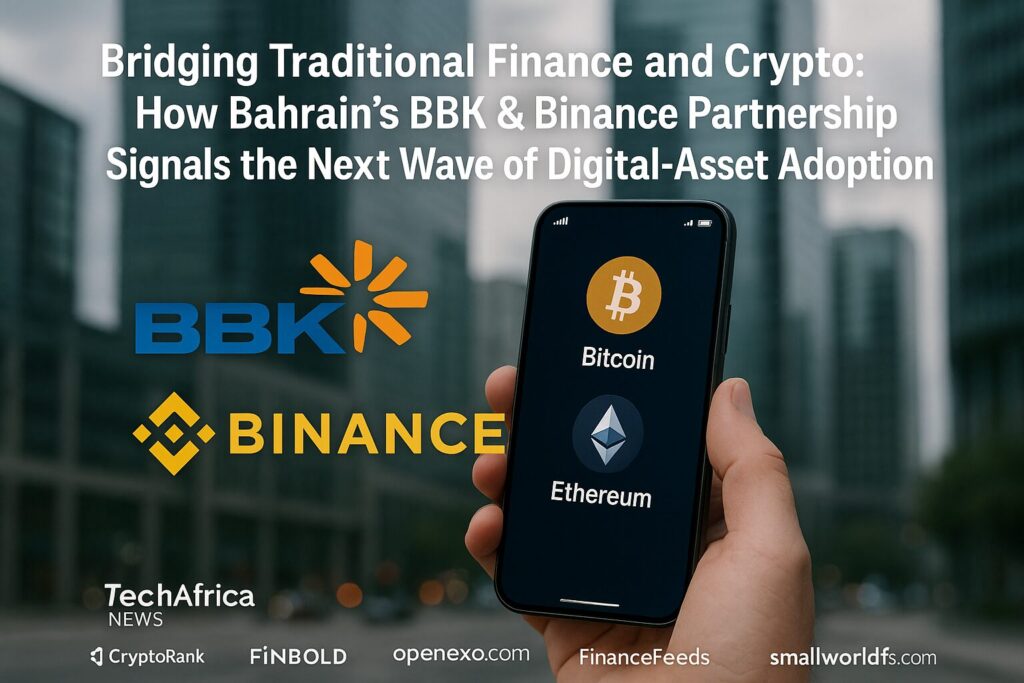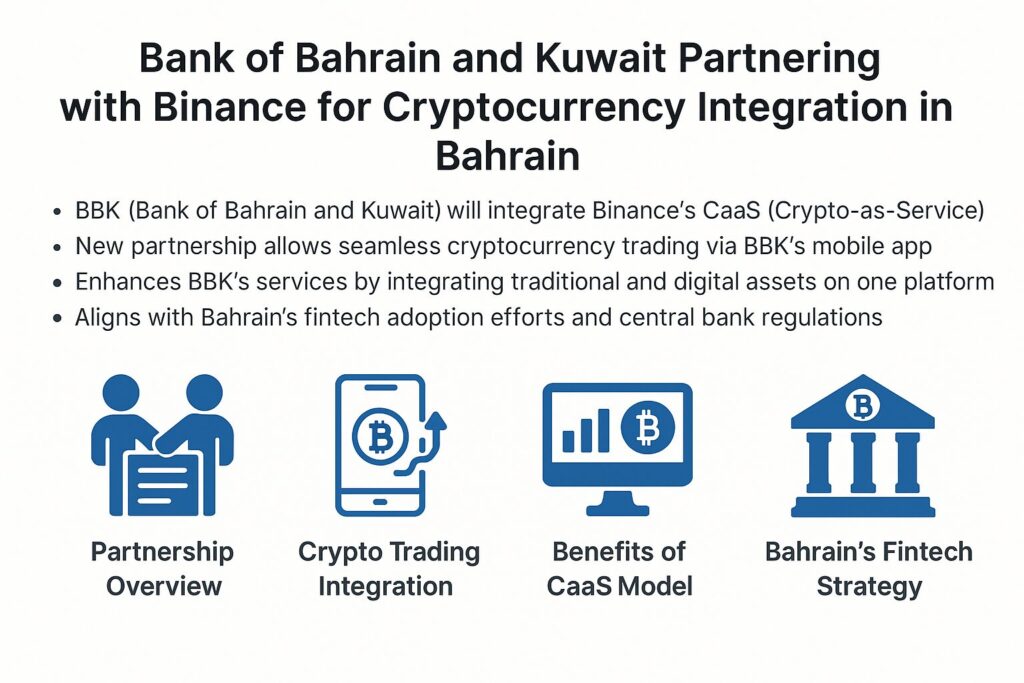
Main Points :
- The Bank of Bahrain and Kuwait (BBK) has signed a Memorandum of Understanding (MoU) with Binance to adopt Binance’s Crypto-as-a-Service (CaaS) and become the first bank in the Gulf Cooperation Council (GCC) region to integrate crypto services directly into its mobile banking app.
- Through the white-label solution and plug-and-play APIs, BBK customers will be able to buy, sell and manage digital assets such as Bitcoin and Ethereum directly via BBK’s app—without needing a separate Binance account.
- This move aligns with Bahrain’s ambition to become a fintech and digital‐asset hub in the Middle East, supported by the Central Bank of Bahrain’s relatively progressive regulatory framework for crypto.
- For crypto investors, fintech developers and blockchain practitioners, this development signals deeper institutional adoption of digital assets—not just as isolated from banking, but embedded in mainstream banking interfaces.
- We must also view some of the associated risks: volatility of crypto markets, regulatory uncertainty in the broader GCC, and reputational/regulatory history of platforms like Binance.
1. A Historic Alliance: BBK + Binance

The Bank of Bahrain and Kuwait (BBK) has just made a landmark move by signing an MoU with Binance to integrate the latter’s Crypto-as-a-Service (CaaS) solution into BBK’s mobile banking platform. This makes BBK the first bank in the GCC region to embed crypto trading and asset-management capabilities directly inside a banking app via such infrastructure.
Under the agreement, BBK’s customers will not need to open separate Binance accounts; instead, via BBK’s banking app and a dedicated crypto-dashboard (powered by Binance’s white-label infrastructure), they can view and manage both their traditional investments and digital assets (crypto) in one place.
From the standpoint of blockchain and crypto practice, this indicates a turning point: rather than crypto platforms being separate silos, here we see embedded crypto services inside regulated banking infrastructure.
2. How the CaaS Solution Strengthens BBK’s Service Offering
The CaaS model provided by Binance offers plug-and-play APIs and a white-label backend so an existing bank like BBK can fast-track its digital-asset offering without building all infrastructure in-house.
For BBK and its customers, the benefits are:
- A unified dashboard: customers can view both their fiat/legacy assets and their crypto holdings in one mobile interface.
- Friction reduction: no need to open a separate exchange account, meaning lower onboarding friction and higher user convenience.
- New revenue streams for BBK: by embedding crypto trading/management, BBK can earn commissions/fees from crypto services, effectively broadening its business model beyond traditional banking.
- Competitive differentiation: in a region where many banks have yet to embrace digital asset services, BBK gets a first-mover advantage.
For blockchain practitioners and asset strategists, this means: digital assets are becoming more accessible via mainstream banking channels, thereby expanding the pool of potential investors and bridging between TradFi and DeFi infrastructures.
3. Bahrain’s Fintech & Regulatory Environment: Setting the Stage
The Kingdom of Bahrain has for some time aimed to be a regional fintech and digital-asset hub. The Central Bank of Bahrain (CBB) has issued licenses to crypto-asset service providers and worked to create a regulatory sandbox for digital asset firms.
In this context, BBK’s partnership with Binance aligns with Bahrain’s broader national strategy: embracing digital assets, tokenization, and embedding blockchain technology into mainstream finance. The MoU with Binance was announced during the Gateway Gulf Investment Forum Bahrain 2025, which underlines the government- and regulator-backed nature of this push.
For you as a crypto-asset investor or blockchain practitioner, this environment means that the Gulf region (and Bahrain in particular) is increasingly becoming a pilot zone for regulated crypto adoption, bridging regulatory clarity with innovation. Thus, adopting strategies oriented toward tokenization, embedded banking, and asset-digitization may find favourable tailwinds here.
4. Implications for Crypto Investors and Blockchain Use-Cases
Expanded Access & Mainstreaming
With BBK embedding crypto services in its banking app, a larger class of retail and perhaps institutional customers will have easier access to crypto investments. This fosters liquidity growth and market-depth for major assets (e.g., BTC, ETH) and potentially for tokenised alternative assets (see next section). For you as someone looking for new crypto assets and income opportunities, this is good: the pool of participants expands, which can reduce friction and improve infrastructure.
Tokenization and Asset-Digitization Opportunity
In parallel to the BBK-Binance MoU, BBK has also signed an MoU with ATME (a digital-asset exchange licensed by CBB) to explore distributed-ledger technology (DLT) and tokenization for alternative assets (such as real estate, corporate bonds).
This signifies that the bank is preparing for more than just crypto trading—it is investigating how to digitise real-world assets and present them via blockchain infrastructures. For you designing blockchain applications or exploring income streams in asset-tokenisation, this is a strong signal: banks are planning to open up new classes of tokenised investment products.
Benefits for Blockchain Practitioners
From a technical standpoint:
- The plug-and-play API model of CaaS shows how banks can integrate crypto services, which could be replicated in other geographies.
- The combined dashboard of fiat + crypto suggests UX design and data-architecture challenges (e.g., how to show users hybrid portfolios, reconcile risk profiles across asset classes).
- For your work in developing wallet solutions (such as you mentioned with “dzilla Wallet”), this trend underscores the importance of interoperability between traditional banking rails and crypto rails, and the need for seamless UX/UI.
Income-Stream & Strategy Implications
- For investors: Embedded banking-crypto services lower friction of entry and could increase retail participation—thus possibly influencing price dynamics for major assets and emerging altcoins.
- For tokenisation: If banks add digital-asset services tied to real-world-assets, yield-oriented token investments (e.g., tokenised real estate, tokenised debt) may become more accessible—opening new income-opportunity categories beyond just speculation.
- For blockchain application builders: This is a ripe environment for designing compliant, institutional-grade solutions—especially for markets in Middle East/GCC.
5. Risk Considerations and What to Watch
While the BBK-Binance partnership is highly promising, it is not without risks and caveats:
- Regulatory Approvals Pending: The MoU is subject to final approval from the CBB. Regulatory delays or restrictions could affect rollout and timelines.
- Crypto Market Volatility: Embedding crypto services means bank customers face the inherent volatility of digital assets. A large draw-down in crypto could impact user sentiment and regulatory perception.
- Reputational & Regulatory History of Binance: While Binance has institutional reach, globally it has faced regulatory scrutiny and fines (e.g., in the U.S.). This could raise concerns for conservative banking regulators or institutional clients in the region.
- Broader GCC Regulatory Fragmentation: While Bahrain is progressive, other GCC states (such as Qatar or Saudi Arabia) may have stricter rules or change stance—cross-border effects could complicate the business model.
- Tokenisation Model Execution: While the ambition to tokenise real-world assets is strong, practical implementation (custody, regulation, governance, secondary liquidity) remains complex. Investors and application developers should watch how well BBK/ATME execute.
What to monitor:
- The actual launch date and customer adoption metrics for BBK’s crypto-embedded app.
- Which digital assets are offered (major coins vs altcoins vs tokenised assets).
- Fee structure and economics: how much revenue BBK earns from crypto services and how much clients pay.
- Regulatory signals from Bahrain (or other GCC states) post-launch—are there additional approvals, changes in supervision, or customer disclosures?
- User UX experience: whether the interface meets retail investor expectations and how risk/education is managed.
6. What This Means for You (as a Developer/Investor)
Given your interest in new crypto assets, income-opportunities and blockchain applications, here are actionable takeaways:
- Focus on Markets with Banking-Crypto Integration: Regions where banks embed crypto (like Bahrain) may become early hubs for regulated digital-asset products. Consider monitoring altcoins or tokenised assets that may launch in such markets.
- Develop UX/Wallet Solutions With Banking Integration in Mind: As you build or refine your wallet (e.g., “dzilla Wallet”), think about how to support hybrid portfolios (fiat + crypto), how to integrate with bank APIs or white-label services, and how to design user journeys that mirror the embedded banking model.
- Look at Tokenisation Opportunities: Since BBK is exploring asset tokenisation, anticipate new digital-asset vehicles tied to real-world assets. Early involvement or insight here can open income streams through tokenised real estate, debt, or fractionalised assets.
- Timing and Entry Strategy for Investors: With large institutions entering crypto-services, market-dynamics for major assets may shift (e.g., higher institutional inflow, greater access for retail). From a trading or investment strategy, anticipate possible upticks in liquidity or adoption.
- Build or Use Regulatory-Compliant Infrastructure: Given the regulated banking-crypto model, you may want to consider chains, tokens or platforms that support compliance (e.g., KYC/AML, on-chain audits, asset-backing disclosure).
7. Conclusion: The Bigger Picture
The MoU between BBK and Binance marks a pivotal moment in the evolution of digital assets and blockchain adoption in traditional finance. It underscores that crypto is not just a niche investment but increasingly part of mainstream banking infrastructure. For jurisdictions like Bahrain, it signals a strategic leap toward becoming fintech and digital-asset hubs, leveraging regulation, financial infrastructure and blockchain innovation.
For you—whether as a crypto investor, blockchain developer, or application designer—this signals that the frontier is shifting: from isolated crypto exchanges toward embedded banking-crypto ecosystems; from purely token-speculation to tokenised real-world-asset opportunities; from standalone wallets to integrated financial platforms. The challenge and opportunity lie in aligning with this shift: building infrastructure, spotting assets, and understanding how regulation, UX, and technology converge.
In sum: this partnership is more than a headline—it is a flagpost. It suggests that the next wave of crypto adoption will be driven by regulated banks, embedded services, and tokenised finance—not just by decentralised communities alone. For those seeking the next income-source or application breakthrough, following this trend closely—and designing accordingly—may yield significant advantage.

